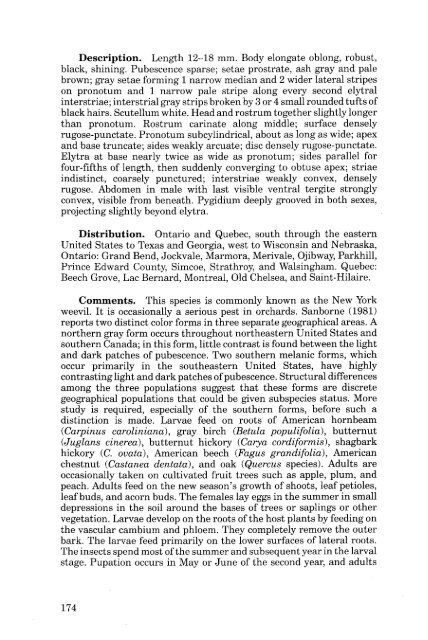Weevils - Entomological Society of Canada
Weevils - Entomological Society of Canada
Weevils - Entomological Society of Canada
Create successful ePaper yourself
Turn your PDF publications into a flip-book with our unique Google optimized e-Paper software.
Description. Length 12-18 mm. Body elongate oblong, robust,<br />
black, shining. Pubescence sparse; setae prostrate, ash gray and pale<br />
brown; gray setae forming 1 narrow median and 2 wider lateral stripes<br />
on pronotum and 1 narrow pale stripe along every second elytral<br />
interstriae; interstrial gray strips broken by 3 or 4 small rounded tufts <strong>of</strong><br />
black hairs. Scutellum white. Head and rostrum together slightly longer<br />
than pronotum. Rostrum carinate along middle; surface densely<br />
rugose-punctate. Pronotum subcylindrical, about as long as wide; apex<br />
and base truncate; sides weakly arcuate; disc densely rugose-punctate.<br />
Elytra at base nearly twice as wide as pronotum; sides parallel for<br />
four-fifths <strong>of</strong> length, then suddenly converging to obtuse apex; striae<br />
indistinct, coarsely punctured; interstriae weakly convex, densely<br />
rugose. Abdomen in male with last visible ventral tergite strongly<br />
convex, visible from beneath. Pygidium deeply grooved in both sexes,<br />
projecting slightly beyond elytra.<br />
Distribution. Ontario and Quebec, south through the eastern<br />
United States to Texas and Georgia, west to Wisconsin and Nebraska,<br />
Ontario: Grand Bend, Jockvale, Marmora, Merivale, Ojibway, Parkhill,<br />
Prince Edward County, Simcoe, Strathroy, and Walsingham. Quebec:<br />
Beech Grove, Lac Bernard, Montreal, Old Chelsea, and Saint-Hilaire.<br />
Comments. This species is commonly known as the New York<br />
weevil. It is occasionally a serious pest in orchards. Sanborne (1981)<br />
reports two distinct color forms in three separate geographical areas. A<br />
northern gray form occurs throughout northeastern United States and<br />
southern <strong>Canada</strong>; in this form, little contrast is found between the light<br />
and dark patches <strong>of</strong> pubescence. Two southern melanic forms, which<br />
occur primarily in the southeastern United States, have highly<br />
contrasting light and dark patches <strong>of</strong> pubescence. Structural differences<br />
among the three populations suggest that these forms are discrete<br />
geographical populations that could be given subspecies status. More<br />
study is required, especially <strong>of</strong> the southern forms, before such a<br />
distinction is made. Larvae feed on roots <strong>of</strong> American hornbeam<br />
(Carpinus cq.roliniana), gray birch (Betula populifolio), butternut<br />
(Juglans cinerea), butternut hickory (Carya cordiformis), shagbark<br />
hickory (C. ouata), American beech (Fagus grandifolia), American<br />
chestnut (Castq.neq. dentata), and oak (Quercus species). Adults are<br />
occasionally taken on cultivated fruit trees such as apple, plum, and<br />
peach. Adults feed on the new season's growth <strong>of</strong> shoots, leaf petioles,<br />
leaf buds, and acorn buds. The females lay eggs in the summer in small<br />
depressions in the soil around the bases <strong>of</strong> trees or saplings or other<br />
vegetation. Larvae develop on the roots <strong>of</strong>the host plants by feeding on<br />
the vascular cambium and phloem. They completely remove the outer<br />
bark. The larvae feed primarily on the lower surfaces <strong>of</strong> lateral roots.<br />
The insects spend most <strong>of</strong> the summer and subsequent year in the larval<br />
stage. Pupation occurs in May or June <strong>of</strong> the second year, and adults<br />
t74

















